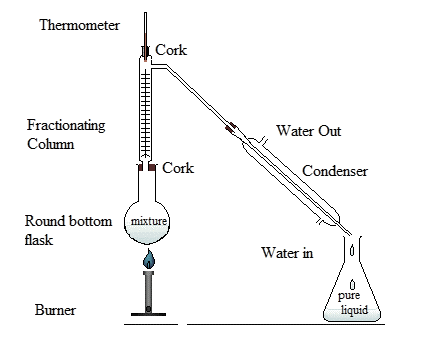
Interpretation:
The process of fractional distillation needs to be described.
Concept introduction:
Distillation technique is used to separate the components of mixture, when the volatility of substances of mixture of two or more substances are different.
Explanation of Solution
In fractional distillation process, heat is used to separate out the various components present in the mixture of miscible liquids. Since, heat is used in this process so, the boiling point of the components in the mixture play an essential role. The process involves repeated distillations and condensations. The basic principle for this process is that different liquids on heating boils and evaporates at different temperatures thus, the component possessing lower boiling point will boil first and gets converted to vapor.
The process of fractional distillation is:
The general setup for fractional distillation will be:

A mixture of two miscible liquids, say A and B is taken where B is more volatile than A. The mixture is taken in round bottom flask which is connected to fractionating column. After applying heat through burner, the temperature increases slowly which can be observed on the connected thermometer. After some time, the mixture will start to boil and vapors (of component B) start rising to the fractionating column and then to condenser in which the vapors are cooled down to convert them into liquid via water inlet and outlet in the condenser. The cooled down liquid of component B is collected in the flask.
Use of fraction distillation: It is used in oil refineries, purification of water and purification of products and reagents.
Chapter 21 Solutions
Chemistry: Matter and Change
Additional Science Textbook Solutions
Inorganic Chemistry
Introductory Chemistry (6th Edition)
CHEMISTRY-TEXT
Introductory Chemistry (5th Edition) (Standalone Book)
Organic Chemistry
Organic Chemistry (8th Edition)
 ChemistryChemistryISBN:9781305957404Author:Steven S. Zumdahl, Susan A. Zumdahl, Donald J. DeCostePublisher:Cengage Learning
ChemistryChemistryISBN:9781305957404Author:Steven S. Zumdahl, Susan A. Zumdahl, Donald J. DeCostePublisher:Cengage Learning ChemistryChemistryISBN:9781259911156Author:Raymond Chang Dr., Jason Overby ProfessorPublisher:McGraw-Hill Education
ChemistryChemistryISBN:9781259911156Author:Raymond Chang Dr., Jason Overby ProfessorPublisher:McGraw-Hill Education Principles of Instrumental AnalysisChemistryISBN:9781305577213Author:Douglas A. Skoog, F. James Holler, Stanley R. CrouchPublisher:Cengage Learning
Principles of Instrumental AnalysisChemistryISBN:9781305577213Author:Douglas A. Skoog, F. James Holler, Stanley R. CrouchPublisher:Cengage Learning Organic ChemistryChemistryISBN:9780078021558Author:Janice Gorzynski Smith Dr.Publisher:McGraw-Hill Education
Organic ChemistryChemistryISBN:9780078021558Author:Janice Gorzynski Smith Dr.Publisher:McGraw-Hill Education Chemistry: Principles and ReactionsChemistryISBN:9781305079373Author:William L. Masterton, Cecile N. HurleyPublisher:Cengage Learning
Chemistry: Principles and ReactionsChemistryISBN:9781305079373Author:William L. Masterton, Cecile N. HurleyPublisher:Cengage Learning Elementary Principles of Chemical Processes, Bind...ChemistryISBN:9781118431221Author:Richard M. Felder, Ronald W. Rousseau, Lisa G. BullardPublisher:WILEY
Elementary Principles of Chemical Processes, Bind...ChemistryISBN:9781118431221Author:Richard M. Felder, Ronald W. Rousseau, Lisa G. BullardPublisher:WILEY





